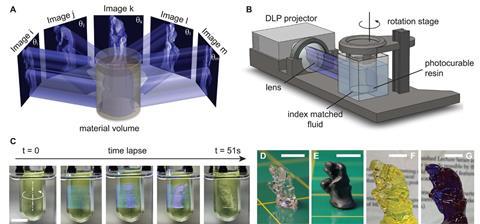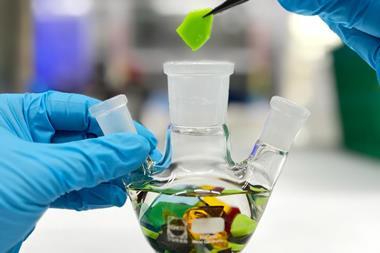CAT scan-inspired 3D printer produces whole objects in seconds
Researchers have 3D printed intricate objects by combining a standard projector and a rotating vial filled with a liquid that hardens when exposed to light. The printer can produce detailed structures in seconds, such as a tiny model of Auguste Rodin’s sculpture The Thinker.
Most 3D printers work by splitting an object into slices and printing each slice on top of the last to build up the object layer by layer. With the printer created by Hayden Taylor’s team at the University of California Berkeley, US, the whole object materialises in one piece inside a liquid-filled container. Taylor was inspired by tomography, which combines 2D cross-sections of an object taken from different angles into a 3D image.
The team first computes 2D projections of an object from different angles. These images are then projected in sequence onto a rotating glass vial containing a mix of diacrylates and two photoinitiators, parbenate and camphorquinone. When exposed to light, the photoinitiators kick off the acrylates’ polymerisation. Once the reaction is complete, the uncured mixture is poured off to reveal the 3D printed sculpture. Making objects around 1cm in height take less than a minute – much faster than layer-by-layer printing.

This approach can print structures that are difficult or impossible to make with regular 3D printers: overhanging features, disconnected parts – like a ball in a cage – and encased pre-existing items. As well as two Thinker sculptures – one 1cm, the other 4cm in height – Taylor’s team printed a tiny bridge, a dental model, a honeycomb lattice with 0.3mm internal voids and even added a handle onto a metal screwdriver shaft.
Even 3D bioprinting might be possible with the light printer. Since the monomer mixture supports the object during printing, the team could carve objects out of a fragile gelatin hydrogel.
References
B E Kelly et al, Science, 2019, DOI: 10.1126/science.aau7114












No comments yet